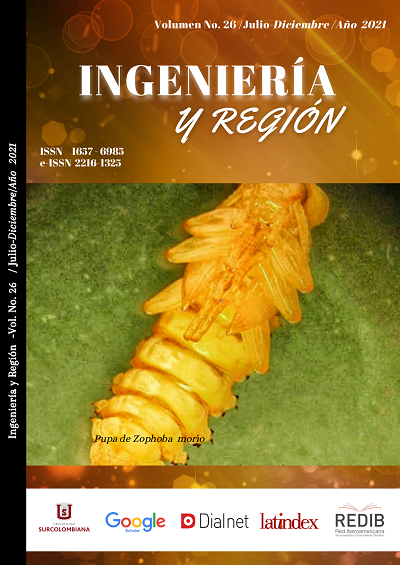Formación de patrones en un modelo difusivo bidimensional depredador - presa tipo Holling II
##plugins.themes.bootstrap3.article.main##
En este trabajo se presenta un método numérico para observar el comportamiento y la distribución en la interacción de las presas y depredadores bajo un modelo difusivo bidimensional con crecimiento logístico para las presas y funcional de depredación tipo Holling II. Al realizar algunas perturbaciones en los parámetros del modelo, determinar condiciones de contornos apropiadas y establecer intervalos de tiempo para la convergencia del método, las soluciones del modelo presentan diversos patrones. En vista que el modelo matemático sin difusión presenta ciclo límite, un equilibrio que puede ser localmente un nodo o una espiral estable, las soluciones numéricas del modelo difusivo reflejan dichos comportamientos.
Descargas
##plugins.themes.bootstrap3.article.details##
Arrowsmith, D., & Place, C. M. (1992). Dynamical systems: differential equations, maps, and chaotic behaviour (Vol. 5). CRC Press. https://doi.org/10.1017/cbo9780511622700
Berkooz, G., Holmes, P., & Lumley, J. L. (1996). Coherent structures, dynamical systems and symmetry. Cambridge Monographs on Mechanics, Cambridge University Press.
Blanchard, P., & Devaney, R. L. (1999). Ecuaciones diferenciales (No. 517.38 B5).
Cárdenas, M. M., Cuenca, J. V., & Betancourth, G. L. (2013). Bifurcaciones en modelos sobre identificación de patrones. Revista Entornos, 26(2), 139-159. https://doi.org/10.25054/01247905.480
Chicone, C. (2006). Ordinary differential equations with applications (Vol. 34). Springer Science & Business Media.
Cohen, M. A., & Grossberg, S. (1983). Absolute stability of global pattern formation and parallel memory storage by competitive neural networks. IEEE transactions on systems, man, and cybernetics, (5), 815-826. https://doi.org/10.1109/tsmc.1983.6313075
Cortés, C. (2017). Identificación de una Bifurcación de Hopf con o sin Parámetros. Revista de Ciencias, 21(2), 59-82. https://doi.org/10.25100/rc.v21i2.6699
Cortés, C. (2021a). Bifurcaciones en Modelo Gause Depredador-Presa con discontinuidad. Revista de Matemática: Teoría y Aplicaciones, 28(2), 183-208.
Cortés, C., Ramírez-Fierro, A. (2021b). Solución tipo onda viajera en un Modelo Difusivo Depredador-Presa tipo Holling II. Revista de Matemática: Teoría y Aplicaciones, 28(2), 209-236.
Cross, M., & Greenside, H. (2009). Pattern formation and dynamics in nonequilibrium systems. Cambridge University Press.
Cruywagen, G. C., Murray, J. D., & Maini, P. K. (2000). An envelope method for analyzing sequential pattern formation. SIAM Journal on Applied Mathematics, 61(1), 213-231. https://doi.org/10.1137/s003613999732857x
Doelman, A., & Van Harten, A. (1995). Nonlinear dynamics and pattern formation in the natural environment (Vol. 335). CRC Press.
Du, Y., & Shi, J. (2006). A diffusive predator–prey model with a protection zone. Journal of Differential Equations, 229(1), 63-91. https://doi.org/10.1016/j.jde.2006.01.013
Edelstein, L., (1988). Mathematical Models in Biology. New York. SIAM Edition.
Freedman, H. I. (1980). Deterministic mathematical models in population ecology (Vol. 57). Marcel Dekker Incorporated.
Garvie,M., Trenchea, C., (2005a). Analysis of two generic spatially extended predator–prey models. Nonlinear Anal.
Garvie, M., Trenchea, C.,(2005b). Finite element approximation of spatially extended predator–prey interactions with the Holling type II functional response. https://doi.org/10.1007/s00211-007-0106-x
Garvie, M.,(2007). Finite-Difference Schemes for Reaction–Diffusion Equations Modeling Predator–Prey Interactions in MATLAB. Bulletin of Mathematical Biology (69): 931–956. https://doi.org/10.1007/s11538-006-9062-3
Ghazaryan, A., Manukian, V., & Schecter, S. (2015). Travelling waves in the Holling–Tanner model with weak diffusion. Proceedings of the Royal Society A: Mathematical, Physical and Engineering Sciences, 471(2177), 20150045. https://doi.org/10.1098/rspa.2015.0045
Golubitsky, M., Luss, D., & Strogatz, S. H. (1999). Pattern formation in continuous and coupled systems (pp. 65-82). Springer.
Grindrod, P. (1991). Patterns and waves: The theory and applications of reaction-diffusion equations. Oxford University Press.
Hasik, K. (2010). On a predator–prey system of Gause type. Journal of Mathematical Biology, 60(1), 59-74. https://doi.org/10.1007/s00285-009-0257-8
Hirsch, M. W., & Smale, S. (1974). Difierential Equations. Dynamical Systems, and Linear Algebra. San Diego: Academic Press.
Hong, K., & Weng, P. (2013). Stability and traveling waves of a stage-structured predator–prey model with Holling type-II functional response and harvesting. Nonlinear Analysis: Real World Applications, 14(1), 83-103. https://doi.org/10.1016/j.nonrwa.2012.05.004
Huang, J., Lu, G., & Ruan, S. (2003). Existence of traveling wave solutions in a diffusive predator-prey model. Journal of Mathematical Biology, 46(2), 132-152. https://doi.org/10.1007/s00285-002-0171-9
Ai, S., Du, Y., & Peng, R. (2017). Traveling waves for a generalized Holling–Tanner predator–prey model. Journal of Differential Equations, 263(11), 7782-7814. https://doi.org/10.1016/j.jde.2017.08.021
Hoyle, R., & Hoyle, R. B. (2006). Pattern formation: an introduction to methods. Cambridge University Press.
Iserles, A. (2009). A first course in the numerical analysis of differential equations (No. 44). Cambridge university press.
Kuang, Y., & Freedman, H. I. (1988). Uniqueness of limit cycles in Gause-type models of predator-prey systems. Mathematical Biosciences, 88(1), 67-84. https://doi.org/10.1016/0025-5564(88)90049-1
Kuznetsov, Y. A., (1998). Elements of Applied Bifurcation Theory. Applied Mathematical Sciences, (112) New York. Second Edition.
Li, W. T., & Wu, S. L. (2008). Traveling waves in a diffusive predator–prey model with Holling type-III functional response. Chaos, Solitons & Fractals, 37(2), 476-486. https://doi.org/10.1016/j.chaos.2006.09.039
Lin, Q., Xie, X., Chen, F., & Lin, Q. (2018). Dynamical analysis of a logistic model with impulsive Holling type-II harvesting. Advances in Difference Equations, 2018(1), 1-22. https://doi.org/10.1186/s13662-018-1563-5
Liu, P. P. (2010). An analysis of a predator–prey model with both diffusion and migration. Mathematical and Computer Modelling, 51(9-10), 1064-1070. https://doi.org/10.1016/j.mcm.2009.12.010
Mancini, H. L. (Ed.). (2007). New trends, dynamics and scales in pattern formation. EDP Sciences.
Mathews, J. H., Kurtis, D. F., (2000). Métodos Numéricos con MATLAB. Editorial Pearson Prentice Hall. Tercera edición.
Mukherjee, D., & Maji, C. (2020). Bifurcation analysis of a Holling type II predator-prey model with refuge. Chinese Journal of Physics, 65, 153-162. https://doi.org/10.1016/j.cjph.2020.02.012
Murray, J. D. (2002). Mathematical Biology I. An Introduction. JD Murray.
Murray, J. D., & Oster, G. F. (1984). Generation of biological pattern and form. Mathematical Medicine and Biology: A Journal of the IMA, 1(1), 51-75.
Rao, F., & Kang, Y. (2016). The complex dynamics of a diffusive prey–predator model with an Allee effect in prey. Ecological complexity, 28, 123-144. https://doi.org/10.1016/j.ecocom.2016.07.001
Renardy, M., & Rogers, R. C. (2006). An introduction to partial differential equations (Vol. 13). Springer Science & Business Media.
Sauser, T., (2013). Análisis Numérico. Segunda edición. México. p. 664. Editorial Pearson Educación.
Sotomayor, J. (1979). Liçoes de equaçoes diferenciais ordinárias (Vol. 11). Instituto de Matemática Pura e Aplicada, CNPq.
Tang, G., Tang, S., & Cheke, R. A. (2014). Global analysis of a Holling type II predator–prey model with a constant prey refuge. Nonlinear Dynamics, 76(1), 635-647. https://doi.org/10.1007/s11071-013-1157-4
Tian, X., & Xu, R. (2011). Global dynamics of a predator-prey system with Holling type II functional response. Nonlinear Analysis: Modelling and Control, 16(2), 242-253. https://doi.org/10.15388/na.16.2.14109
Wolkowicz, G. S. K. (1988). Bifurcation analysis of a predator-prey system involving group defence. SIAM Journal on Applied Mathematics, 48(3), 592-606. https://doi.org/10.1137/0148033
Wu, X., Luo, Y., & Hu, Y. (2014). Traveling waves in a diffusive predator-prey model incorporating a prey refuge. In Abstract and Applied Analysis (Vol. 2014). Hindawi. https://doi.org/10.1155/2014/679131
Wu, S., Wang, J., & Shi, J. (2018). Dynamics and pattern formation of a diffusive predator–prey model with predator-taxis. Mathematical Models and Methods in Applied Sciences, 28(11), 2275-2312. https://doi.org/10.1142/s0218202518400158
Zhou, Y., Sun, W., Song, Y., Zheng, Z., Lu, J., & Chen, S. (2019). Hopf bifurcation analysis of a predator–prey model with Holling-II type functional response and a prey refuge. Nonlinear Dynamics, 97(2), 1439-1450. https://doi.org/10.1007/s11071-019-05063-w
Zhu, H., Campbell, S. A., & Wolkowicz, G. S. (2003). Bifurcation analysis of a predator-prey system with nonmonotonic functional response. SIAM Journal on Applied Mathematics, 63(2), 636-682. https://doi.org/10.1137/s0036139901397285
Zu, J., & Mimura, M. (2010). The impact of Allee effect on a predator–prey system with Holling type II functional response. Applied Mathematics and Computation, 217(7), 3542-3556. https://doi.org/10.1016/j.amc.2010.09.029


















